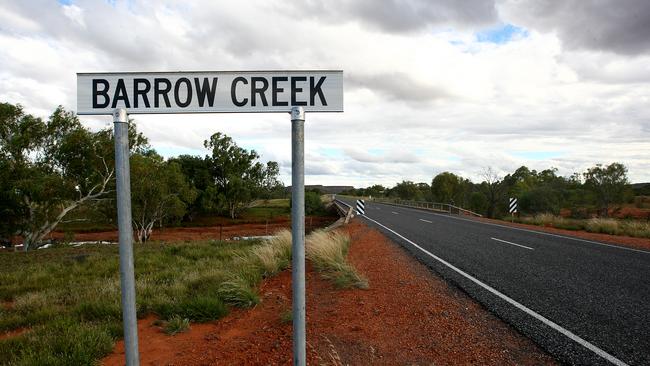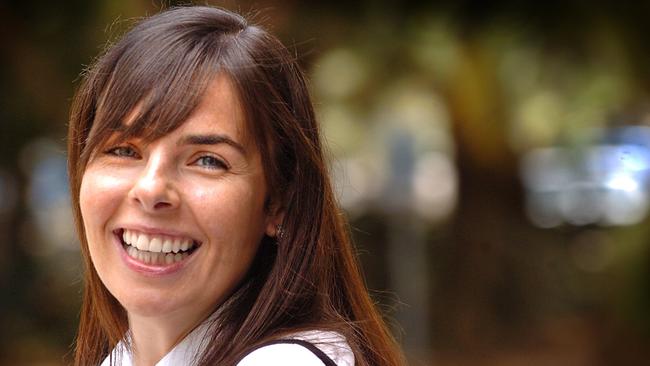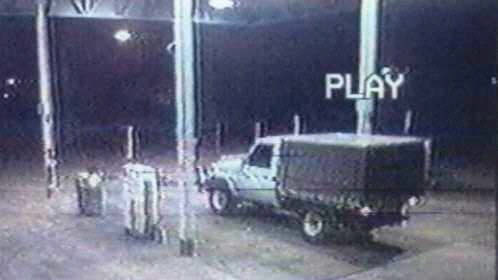Andrew Rule: New documentary raises old questions about Falconio death
The mysterious outback murder of Peter Falconio mystified audiences across two nations, but questions and inconsistencies have persisted long after the man convicted of his killing was put behind bars.

VIC News
Don't miss out on the headlines from VIC News. Followed categories will be added to My News.
When the cell door clanged behind Bradley John Murdoch in 2005, most Australians probably assumed the Northern Territory police had got it right for a change. After four years, they’d finally put away the Falconio killer.
Others might have been intrigued by the loose ends and apparent inconsistencies in the case.
It was the manacled and terrified Joanne Lees, girlfriend of Peter Falconio, who ran and hid under a bush close to the Stuart Highway on July 14, 2001, and was not found by the attacker in the several hours after he had pulled over the couple in their Kombi van early that Saturday night.
She had heard a bang, maybe a gunshot, after Falconio got out of the van. She never saw him again. She escaped into the darkness after the man manacled her and forced her into the back of his ute.
When Bradley Murdoch was arrested in 2003 after a secret investigation based on information from a criminal associate of his, some might have wondered if the police got the right man after all. A few might have been outraged about the possibility of a miscarriage of justice, although the hulking Murdoch seemed an unlikely poster boy for an “innocence project.”
Then there’s the Lees factor. She has always attracted attention and speculation because she combines striking looks with a prickly persona.
Like Lindy Chamberlain, crucified by public opinion for years thanks to blinkered and bigoted 1980s Territory police, Lees did not behave the way most people expect someone in her position to behave.
The English rose was all thorns and, in the beginning, even got police off side. She was more defiant and defensive than demure or diplomatic. In an early interview about the most terrifying hours of her life, she bluntly accused investigators of treating her like a suspect instead of looking for “Pete”.
She was right. Initially, police had to treat her as a potential suspect. They noted 34 inconsistencies in her account. Body language experts raised questions about her behaviour when they reviewed the videotapes.
This does not mean Lees was lying, only that she acted differently from most victims and omitted things she thought irrelevant.
The truth behind her “guilty” demeanour, revealed through phone records, was that she’d had an affair with a man in Sydney and had been in constant touch with him. Underneath the shock and trauma, she was desperate not to air dirty laundry with police and the public. Or, of course, with the grieving family of the man she’d intended to marry.
It was a terrible dilemma. If she’d been given a “lie detector” test, she would probably have failed it. But that does not implicate her in what happened to Falconio.

With Lindy Chamberlain, the public eventually realised that the stoic New Zealander never actually had anything to hide behind her flinty exterior and religious faith. Joanne Lees might now well hope for the same outcome when placed under the microscope in a documentary series already seen in the UK and launching on the Seven network on Sunday.
The lingering interest in Lees is partly due to her looks. Like Schapelle Corby, the celebrated drug “mule” arrested in Bali in 2005, Lees has a face that people remember: vivid eyes, regular features and straight black hair that caused one Fleet St reporter to liken her to Cleopatra, partly for her haughtiness.
Lees not only looked like a soapie star, she acted as petulantly as one, which did her no favours. That’s made clear in the documentary, Murder In The Outback.
Not quite so clear after four episodes is whether the conviction against Murdoch is as unassailable as it seemed in 2005. It raises some questions that, technically at least, might sway a jury.
The odds are that Murdoch murdered Peter Falconio and tried to abduct Joanne Lees. But you would have to have touching faith in the Territory police to bet confidently about a guilty verdict if Murdoch got another trial based on evidence raised by the documentary.
Whereas the prosecution has to prove its case, all the defence has to do is raise doubt. And the man behind the documentary once raised doubts for a living, acting for everyone from Alan Bond to the Moran crime family and the Walsh St killers, before falling foul of the law himself.
Andrew Fraser is no longer a practising lawyer but he’s having one last throw at the stumps.

Nailing a bad guy who got away with murder is good. Exposing the fact someone was jailed for a crime they did not commit is better: 24-carat gold for those in the business of true crime stories. Righting wrongs by overturning unjust convictions is great box office.
Everyone who’s seen Making A Murderer and its imitators wants to make multi-part crime documentaries with facts rearranged and packaged as entertainment with all the trimmings: story arcs, plot twists and cliffhanger suspense, real or confected.
Andrew Fraser was approached by associates of Bradley Murdoch long before the Netflix phenomenon. After years of research, Fraser (and his then business partner, Victor Susman) produced a work-in-progress in 2017. Now, with production house CJZ primping and padding that material, it is a polished four-part series.
The Falconio case transcends national borders because the victims are English tourists, which quadruples the audience immediately. For Poms, it’s Midsomer Murders Down Under, with kangaroos and galahs.
Seven is giving it the blockbuster treatment because of the lingering notoriety over the presumed murder of the missing Falconio and the attempted abduction of Lees — and the subsequent conviction of Murdoch.
Murdoch is not exactly a charismatic accused. He has crime “form”. By any account, he is a violent, drug-running gun nut that most people might think better off behind bars.
But is he the violent, drug-running gun nut that killed and/or abducted Peter Falconio? Or was it some other ugly mug in another 4WD ute, a description that fits about half the Territory’s male population? Is there a sliver of doubt?

Those questions seem harder to ridicule after watching Murder In The Outback, which has enough new and recycled material for a strong two-parter or a crackerjack one-hour special. That’s no criticism, just a reflection on the nature of slick, commercial infotainment shows sprinkled with fairy dust: shots of wildlife and sunsets and distant horizons to eke out key interview footage.
Fraser and Susman (no longer friends) have mined thousands of pages of police and prosecution documents and found things kept out of Murdoch’s trial. They re-interviewed experts and vital witnesses and some that are merely interesting, such as the couple who swear they saw Falconio days after July 14.
Fraser builds a defence case that can be reduced to a short list of questions the average bystander might like to see answered. As might a jury if Murdoch were ever given a retrial, which is Fraser’s aim.
First, there’s truck driver Vince Millar, who rescued Lees after she ran across the highway late on the night of the attack. Millar is filmed reading aloud the police statement he made the morning after. He reads it, radiating disbelief, then claims the police entirely misquoted him.
The statement begins with Millar supposedly saying he saw a female with her hands manacled run onto the road. Millar says that in fact he had no idea if the running figure was male or female, let alone manacled, as he slammed on the brakes to avoid hitting them.
In truth, his description of Lees does not matter one bit. What does matter is that his words were changed at will — that the statement might have been redrafted to suit the prosecution. Millar tells Fraser that just before Murdoch’s trial, police told him the first two pages of his original statement were “lost” and wanted him to sign a replacement version omitting an event that happened that night.
Minutes before seeing Lees, Millar says, he saw a red car beside the highway, with two men holding a sick or injured third man wobbling “like jelly”. Millar says he pulled up to offer help but that the pair pushed the man into the car and sped off. This was left out at trial because police apparently considered it irrelevant. But it could have provided a toehold for the defence. Which is Fraser’s point exactly.
The de facto defence case that Fraser stitches together on camera suggests that there was at least one potential killer around that might have done the deed. It’s true that Fraser makes his share of sweeping assertions that can be rebutted by other sweeping assertions. But the evidence he gathers from three respected forensic experts, three truck drivers and a roadhouse proprietor all give pause for thought.
Prof. Barry Boettcher is the scientist who exposed the shamefully botched evidence that got Lindy Chamberlain wrongfully convicted in 1982 for killing her baby daughter Azaria. Boettcher and another DNA expert, Dr Brian McDonald, believe the prosecution case in fact rests only on one spot of DNA found on Joanne Lees’s tee shirt.
The mystery is: how one tiny fleck of Murdoch’s blood got on the shirt? If it wasn’t deliberately placed there through “noble cause” corruption (which used to happen too much in hard-to-prove murder cases) or laboratory contamination, it is conceivable (says Fraser) it happened because both Murdoch and Lees visited the same fast food store in Alice Springs.
Off camera, Fraser says he has reason to believe that Murdoch also attended the Camel Cup in Alice Springs while Falconio and Lees were there. And that the couple shared an Alice Springs taxi with an unknown man.

Crucially, the scientists say that the DNA samples from the Kombi van which the jury accepted were Murdoch’s were in fact weak “mixtures” that might not have come from Murdoch at all. In other words, they say, modern science cannot place the bad man in the van.
Then there’s the Shell service station security footage of a man roughly matching Murdoch’s description (hair, moustache, cap, 4WD ute) who called in late on the night in question. The police case is that Murdoch drove back to Alice Springs, stopped for fuel, then took the Tanami road to Darwin, giving him time to get rid of Falconio’s body.
But an identity expert states that the man in the film is some 10cm shorter than the gigantic Murdoch, who is almost two metres tall. Given that the ute the filmed man stands next to is provably 190cm high, it appears to the casual viewer that he is only around 185cm. Another problem for the prosecution.
So is the testimony of a truck driver, Phil Cook, who had a troubling conversation with a weirdly talkative man (not named for legal reasons) at Barrow Creek soon after the incident. He matched the description given by Lees of a longish-haired man in cap and checked shirt, except for the droopy moustache, which he told Cook he’d just shaved off. When Cook asked if he had a dog (like the attacker) he said he’d shot his dog.
Police found a shot dog near the highway soon afterwards. Exactly how or why they eliminated that man from their inquiries was never revealed.
There are other unanswered questions. Such as the possibility that Falconio, known by his English mates as “Dodgy Pete”, might secretly have agreed to run a parcel of drugs to Darwin — totally without Joanne’s knowledge — and tried to double-cross his minder. Or was himself ambushed by the murderous minder following the van on the lonely highway?
THE FIRST EPISODE OF ‘MURDER IN THE OUTBACK’ STARTS ON CH. 7 TONIGHT
MORE NEWS
NEW CLAIM PETER FALCONIO ‘FAKED HIS OWN DEATH’
PETER FALCONIO COULD BE ‘JELLY MAN’: WITNESS
Originally published as Andrew Rule: New documentary raises old questions about Falconio death

